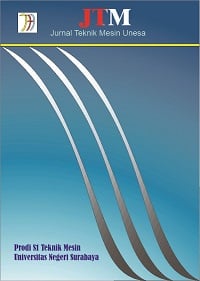SIMULASI NUMERIK SAYAP DENGAN AIRFOIL NACA 4412 DENGAN VARIASI SYMMETRY DAN ASYMMETRY SWEEP TERHADAP GAYA ANGKAT DAN GAYA HAMBAT
Abstract
Wings are the most important component of an airplane or unmanned aerial vehicle, when an object of various shapes is subjected to a flowing fluid, it will produce lift and drag. The airfoil of a wing can affect the performance that produced by the aircraft, which is in the form of maneuverability of the aircraft. By offering a sweep angle, it will change the airfoil to be larger or smaller according to the design, thus having an impact on the maneuverability of the aircraft. The purpose of this study was to determine the effect of variations in leading edge sweep angle 0?; 11,10?; and 21,42? to the value of lift, drag, pressure coefficient, and flow characteristic on the wing with NACA 4412 airfoil. This study use a simulation approach, with the object being studied is a wing with NACA 4412 airfoil. In the data collection technique, the software that act as the research instrument is Computational Fluid Dynamic (CFD) numerical simulation software. The mesh that used is poly-hexcore, but near the body is treated with inflation layer with quadrilateral mesh. The result data that is analyzed are contour velocity, pressure contour, lift (FL), drag (FD), and pressure coefficient (Cp). From the simulation results, it can be seen that varying the sweep angle, it can affect the flow characteristic on the wing. The greater the sweep angle, the higher the lift and drag force, and the resulting Cp value on the trailing edge increase which causes the pressure distribution on the lower surface of the wing increase. Considering the data that are obtained, it is known that the largest FL/FD is at sweep angle 0?, then sweep angle 0? on NACA 4412 airfoil is chosen as the best variant.
Keywords: Lift, Drag, Sweep angle, NACA 4412
Downloads
 Abstract views: 309
,
Abstract views: 309
, PDF Downloads: 475
PDF Downloads: 475


